And here is my second one, this time in mustard yellow cotton poplin with white piping at the waist and neckline. I'm really pleased with it! Here are some pictures of me oddly dancing in the living room!

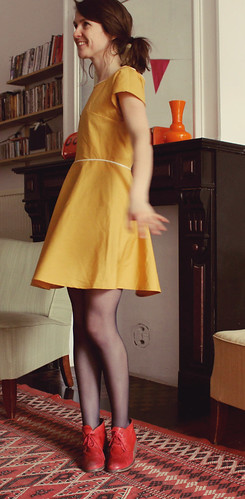
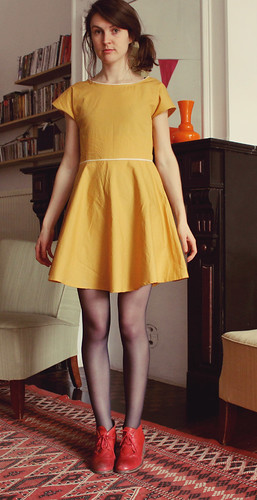
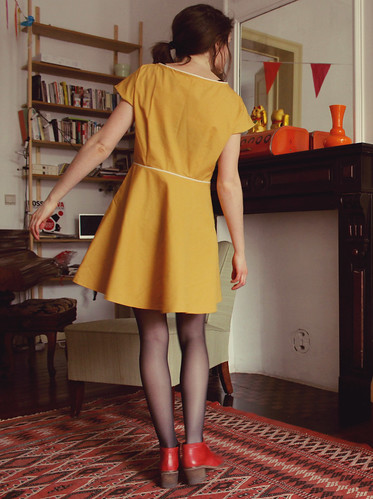
This time I took in some of the excess at the back by slashing and spreading at two points on the back neckline, and I took more care to draft the circle skirt so that it matched up exactly to the bodice. I also shortened the skirt - last time I accidentally cut far too much fabric, and the resulting dress was longer than I had intended.
And, *sewing geek alert*, I've set out below the different stages behind drafting a circle skirt to attach to an existing bodice pattern.
>> First of all: How to work out your finished pattern waist measurement
When you want to draft a circle skirt to attach to a bodice you don't use your actual waist measurement you use the waist measurement of your finished bodice pattern pieces, so that your bodice and skirt pieces correspond and match up nicely.
The following sums will help you work out your finished pattern waist measurement:
1) On back and front pattern pieces (don't include any darts) measure the waistline measurements.
2) Then substract the seam allowance (SA) from both these numbers.
3) Multiply the figures by 2 to get the full front and back bodice waist measurements.
See my working here using my own pattern piece measurements:

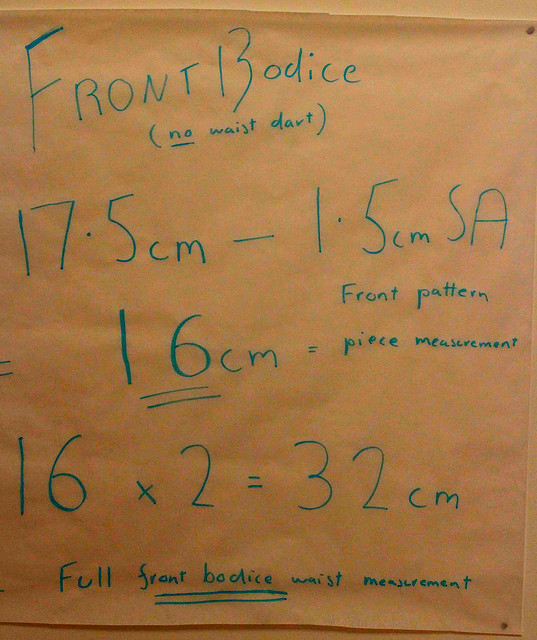
4) Then add these figures together to get your finished pattern waist measurement. This is the measurement you will use to draft your circle skirt.
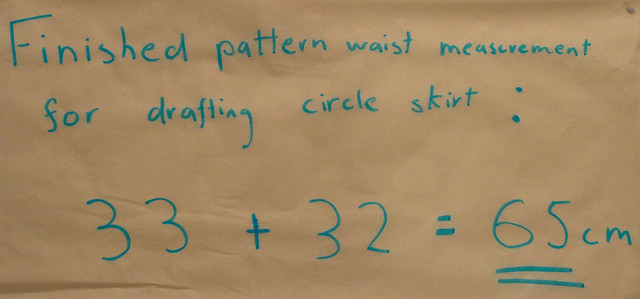
>> The circle skirt calculation
First of all I followed the By Hand London method for drafting a circle skirt, and instead of just using the app, this time I also did the full calculation before checking that the result matched the app result (it did). Not because I didn't trust the app, on the contrary, how could you not trust something formed in the minds of the BHL ladies? No, I just wanted to make sure I fully understood where the answer comes from.
So here is my working:
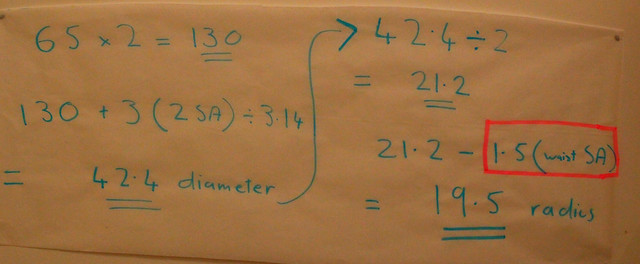
(result rounded to nearest 0.5 of a centimetre)
HOWEVER, when I cut out my skirt pieces the skirt waist circumference was not long enough to match up with the bodice. DISASTER! It took me a while to work out why (and I'm still not 100% sure I fully understand) but I think the part of the calculation highlighted in pink (in the diagram above) is the little culprit.
Let's go back a bit to try and understand: why do we subtract the seam allowance (SA) from the radius (the part in pink)? By subtracting the SA from the radius what you are actually doing is adding the seam allowance, even though you are 'subtracting'. By subtracting from the radius value you 'pull up' the waist line adding your seam allowance at the waist.
If you have a look at this diagram (below) it should make sense.
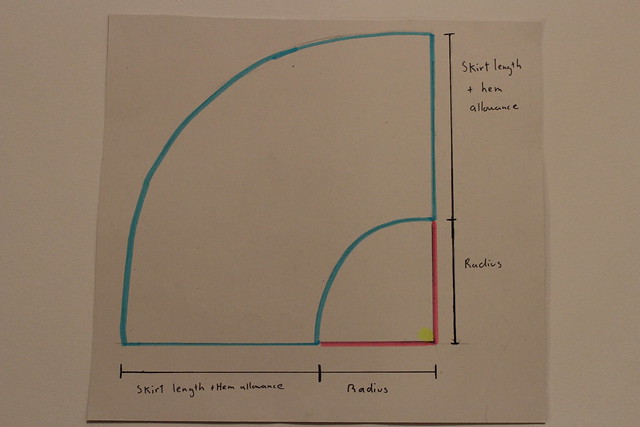
Imagine the radius line getting smaller (subtracting from the radius value), this would add a seam allowance at the waistline.
Now imagine the radius line getting bigger (by adding to the radius value) and you would actually be eating into the skirt, and the skirt waist circumference would be wider - the complete opposite of what you want to do.
This is all well and good for a circle skirt on its own, but when it comes to drafting a circle skirt to attach to a bodice, by adding a seam allowance at the waist (by subtracting from the radius) we effectively 'pulled in' the waist circumference making the skirt piece too small to match up to the bodice.
I rectified this by cutting off the 1.5cm extra, and then it fit nicely to my bodice, this is obviously an easy way to fix it but I'm happy I worked out why the pieces were not joining up so next time I won't have to go through the same process!
So, to sum up: when you are drafting a circle skirt to attach to a bodice you should not add any waist seam allowance as you would do for a circle skirt on its own.
So, I should have used 21cm as my radius value and not 19.5.
If anyone has any experiences to share on this - or any contradictory experiences, I'm still not convinced I've 100% cracked this - don't hesitate to get in touch! I'd be very interested to hear about others' experiences. All in all, I'm really glad I did the sums myself otherwise I wouldn't have been able to work out where the problem was.
>> Now we just need to draft the skirt pattern piece
Once you have your radius value and you know what length you want to make the skirt you can draft your skirt piece.
1) First you need to work out the length of fabric you will need. If I want my skirt to be 61cm long, and I want 2.5cm of hem, and my radius is 19.5, I add all these figures together and I get 83. I checked it out in the app to confirm and sure enough for a 65cm waist midi length skirt the resulting fabric length was 83cm.
NOTE: I obviously should have used 21cm as my radius value, and not 19.5. (see above). Which I will do next time :)
2)Then you draw two long lines at right angles to each other.
3)
On both lines, measure from the right angle point and mark, firstly, the radius point (your radius value from the right angle) and, secondly, your fabric length value.
4) Draw a 45 degree line out from the right angle point and fold your pattern paper along it.
Then you can draft the circle lines (I used a pencil and a shoe lace) on just half of the piece. When you cut through the lines it will be identical on the folded side, giving you a symmetrical cut. I think this is a neat way to do it if you are using the pencil and shoelace method, as it can be a bit fiddly!
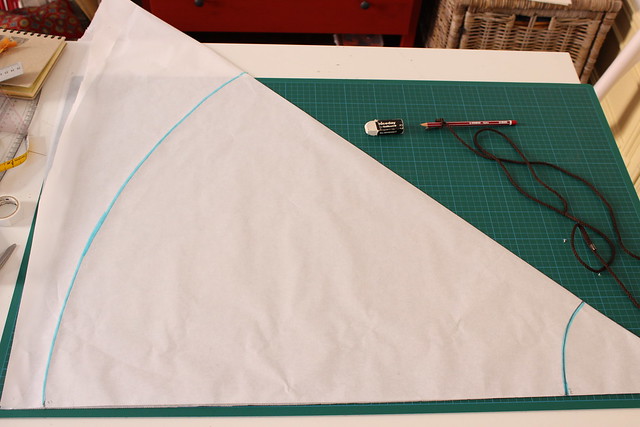
5) Then you can unfold the pattern piece and lay it out on your ironed fabric with one straight edge along the fold.

5) Pin and cut out. Voila, you have your skirt piece!
>> Finally, you can get things moving along!
1. Cut out your bodice pieces.
4) Draw a 45 degree line out from the right angle point and fold your pattern paper along it.
Then you can draft the circle lines (I used a pencil and a shoe lace) on just half of the piece. When you cut through the lines it will be identical on the folded side, giving you a symmetrical cut. I think this is a neat way to do it if you are using the pencil and shoelace method, as it can be a bit fiddly!

5) Then you can unfold the pattern piece and lay it out on your ironed fabric with one straight edge along the fold.

5) Pin and cut out. Voila, you have your skirt piece!
>> Finally, you can get things moving along!
1. Cut out your bodice pieces.
2.
Sew bodice darts, sew shoulder seams (French seams), then sew the raglan sleeve seams by folding them over and pressing twice as you would a hem.
3. Sew one bodice side seam (French seams).
4. Sew bodice to skirt (French seams). At this stage you can also add piping if you like. Just sandwich it into your French seam. As Claudia would say, why wouldn't you?
5. Sew in invisible zip at side seam.
6. Finish side seam.
7. Hem skirt. This BHL post was very useful.
8. Apply bias binding to neckline. Follow this Grainline studio tutorial intently.
ET, ENFIN, C'EST FINI !
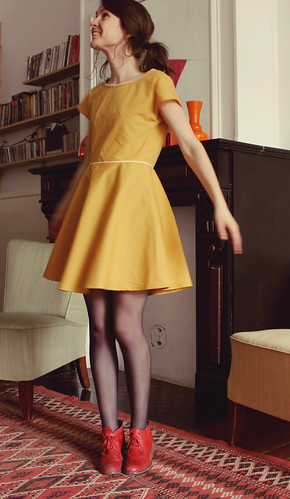
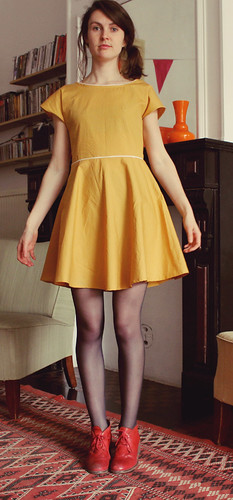

All that's left to say is that I really like this type of '70s yellow', and it reminds me of the lovely hues of the fittings in many of the old Belgian SNCB trains.
And finally...if you have not done so already make sure you support the aforementioned BHL ladies' Kickstarter campaign. Watch their lovely video to find out about their exciting new project.
3. Sew one bodice side seam (French seams).
4. Sew bodice to skirt (French seams). At this stage you can also add piping if you like. Just sandwich it into your French seam. As Claudia would say, why wouldn't you?
5. Sew in invisible zip at side seam.
6. Finish side seam.
7. Hem skirt. This BHL post was very useful.
8. Apply bias binding to neckline. Follow this Grainline studio tutorial intently.
ET, ENFIN, C'EST FINI !



All that's left to say is that I really like this type of '70s yellow', and it reminds me of the lovely hues of the fittings in many of the old Belgian SNCB trains.
And finally...if you have not done so already make sure you support the aforementioned BHL ladies' Kickstarter campaign. Watch their lovely video to find out about their exciting new project.


Cute dress! I love the light touches of contrast piping amid the mustard. Thanks for sharing your method and all those sums - it's really interesting to hear about different techniques and this one seems especially useful! :)
ReplyDeleteThank you! Glad you like the sums! :)
DeleteI can't even begin to get my head round those sums, but I'm sure I'd understand if I actually sat down and followed your instructions :)
ReplyDeleteI LOVE the colour and style of your new dress, and yep, the piping really makes it stand out!
Thanks! I'm going to try and use piping a lot more, really adds to a simple garment and is so simple.
Deleteha, yeah I got a bit into the sums, I hope they are correct! :)
Very cute! I really like the white piping.. I really need to make a circle skirt asap, I'll follow your sums then!
ReplyDelete